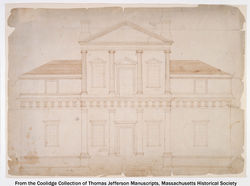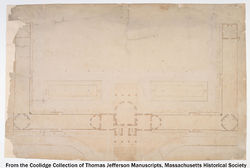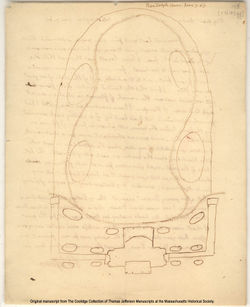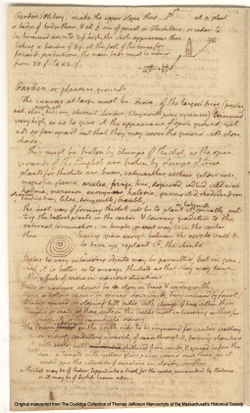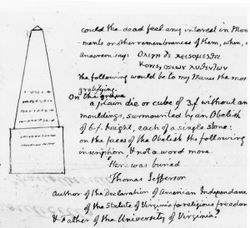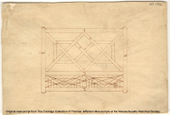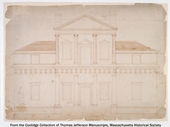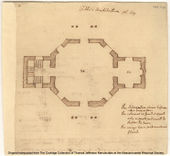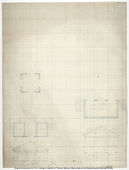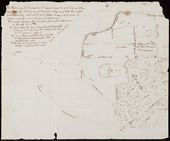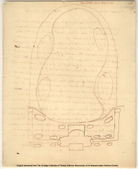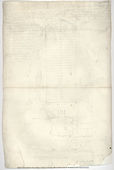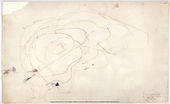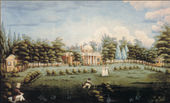Monticello
Monticello, located near Charlottesville, Virginia, was the plantation home of the third president of the United States, Thomas Jefferson (1743–1826). Jefferson designed and redesigned the neoclassical mansion and gardens at Monticello over a period of more than forty years, from approximately 1767 until 1809. Especially notable landscape features include the innovative terraced vegetable garden and vineyards. Today, Monticello is operated as a historic site by the Thomas Jefferson Foundation.
Overview
Site Dates: Active 1767–1826
Site Owner(s): Peter Jefferson (1707/8–1757), Thomas Jefferson (1743–1826), Martha Jefferson Randolph (1772–1836) and children, James T. Barclay (1807–1874), Uriah P. Levy (1792–1862), Jefferson Monroe Levy (1852–1924), Thomas Jefferson Foundation
Associated People: Antonio Giannini (b. 1747, gardener from 1778–1782), Giovannini da Prato (gardener from c. 1781–1812), Robert Bailey (gardener from 1794–1796), Wormley Hughes (1781–1858; enslaved gardener), Tom Shackleford (enslaved gardener), George Granger, Sr. (1730–1799, enslaved gardener and overseer 1796), "Gardener John" (enslaved gardener from 1798–1800), Goliah (enslaved gardener from c. 1802), Edmund Bacon (1785–1866; overseer from 1806–1822), Anne Cary Randolph (1791–1826)
Location: Charlottesville, Va.
View on Google maps
History
Over a period of more than forty years, between approximately 1767 and 1809, Thomas Jefferson designed, constructed, and renovated the house and gardens of his plantation home, Monticello [Fig. 1]. Located on a mountaintop southwest of Charlottesville in the Piedmont region of Virginia, the site was part of the 5,000-acre property in the Rivanna River district that he inherited from his father, Peter Jefferson, in 1757.[1]
Jefferson began planning Monticello in 1767, and construction began two years later. He drew heavily from Andrea Palladio’s Four Books of Architecture (1570) when designing the first version of his neoclassical house, a six-room structure featuring a two-story portico at the entrance [Fig. 2]. In an architectural memorandum that he wrote in 1769, for example, Jefferson recorded specific figures from Palladio's text as well as from James Gibbs's Rules for Drawing the Several Parts of Architecture (1738), to which he referred during the construction of Monticello.[2] He held copies of both architectural treatises as part of his extensive personal library, which contained a significant collection of architecture and landscape design literature.[3] On November 26, 1770, Jefferson moved from Shadwell, his childhood home in Albemarle County, Virginia, to Monticello, occupying the top floor of the recently completed South Pavilion, the first brick building to be constructed on the property.[4] In 1782 the French Major General François-Jean Beauvoir, Marquis de Chastellux, an early visitor to Monticello, wrote that Jefferson was "the architect, and often one of the workmen" on the project and described the house, then still in progress, as “very elegant,” proclaiming “Mr. Jefferson is the first American who has consulted the fine arts to know how he should shelter himself from the weather” (view text). By the summer of 1784, when Jefferson departed for Paris to serve as minister to France, the exterior of the first house at Monticello was largely complete but the interior remained unfinished.[5]
Whereas much is known about the construction of the dwelling during this initial phase, the landscape design during this period is less well understood. On May 155, 1768, Jefferson recorded in his Account Book that he had contracted with John Moore to clear and level 250-square-feet of the mountaintop before Christmas, so that construction of the new house could begin.[6] By by summer of 1769, Jefferson had planted fruit trees in an orchard on the southeast side of the mountain and begun also begun preparations for a kitchen garden. By the end of September, a park with a circumference measuring 1,850 yards had been cleared on the north side.[7] By 1772 work had begun on the first (or uppermost) of four roundabouts—roads that Jefferson had workers clear to encircle the mountain at different elevations. The roundabouts were connected to one another by roads that cut across the mountainside obliquely, as seen in this 1809 survey by Jefferson of the mountaintop [Fig. 3].[8]
Jefferson also recorded an elaborate landscaping plan for Monticello in his Account Book of 1771, but much of the design was never realized. In the plan, he called for the establishment of a burial ground with a “small Gothic temple of antique appearance” and the construction of a temple or grotto by the spring on the north side of the property. He also planned to thin the trees throughout the grounds and “intersperse Jessamine, honeysuckle, sweetbriar, and...hardy flowers” (view text).[9] Two early plans by Jefferson of the house and surrounding grounds indicate that he intended to create rectangular flower beds on the west side of the mansion and a semicircular arrangement of trees on the east side, but these features were not added until more than three decades later [Figs. 4–5]. Additional clues about Jefferson’s planting activities during these early years are provided in his Garden Book, which he maintained between 1766 (while still living Shadwell) and 1824. According to Jefferson’s records, numerous trees and flowers had been planted before he departed for Europe in 1784. This suggests the presence of flower beds near the house, although their exact location is undetermined.[10]
Jefferson cultivated a wide variety of fruits and vegetables at Monticello, planting an orchard, as noted above, as early as 1768 and a vegetable garden and vineyards by 1774. Under the guidance of Filippo Mazzei (1730–1816)—a Florentine horticulturalist and wine merchant who befriended Jefferson and settled in Albemarle County in 1773—Jefferson hired professional Italian gardeners Antonio Giannini and Giovanni da Prato to oversee the care of his fruit trees and vineyard.[11] Enslaved gardeners such as George Granger, Sr., carried out much of the day-to-day work caring for the “orchards, grasses &c.”[12]
The five years that Jefferson spent abroad had a significant impact on his views of domestic architecture and landscape design.[13] During a visit to England in April 1786, Jefferson, accompanied by John Adams (1735–1826), visited sixteen English gardens, using Thomas Whateley’s Observations on Modern Gardening (1770) as his guide.[14] He recorded his impressions in his travel diary. Jefferson apparently disliked the more formal gardens he visited, complaining, for example, that Chiswick House “shows still too much of art” and that the gardens at Hampton Court Palace were “old fashioned.” He preferred the style of the gardens at Esher Place, remarking that the clumps of trees “balance finely–a most lovely mixture of concave and convex.”[15]
Jefferson returned from Europe in 1789, eager to transform Monticello according to his new ideas. In a letter to Angelica Schuyler Church (1756–1814), written just before he departed for Virginia, Jefferson wrote that he looked forward to being “liberated from the hated occupations of politics” so that he could turn his attention back to Monticello: “I have my house to build, my fields to form, and to watch for the happiness of those who labor for mine” (view text). However, just a few months after landing in the United States, President George Washington appointed Jefferson the first U.S. secretary of state, a position he held through 1793. The implementation of his new plans for Monticello would have to wait. Jefferson’s son-in-law Thomas Mann Randolph (1768–1828), with the participation of Jefferson’s daughters Martha Jefferson Randolph (1772–1836) and Mary Jefferson (1778–1804), directed basic farming and gardening activities in Jefferson’s absence.[16]
Jefferson resigned as secretary of state in January 1794 and retired to Monticello. Lucia Stanton has argued that Jefferson was largely focused between 1794 and 1796 on reorganizing the plantation, dividing it into quarter farms—each with seven fields of forty acres—in a “quest for economy and efficiency.” Perhaps the most significant transformation during these years was Jefferson’s decision, in an effort to reverse soil exhaustion, to replace tobacco with wheat as the plantation’s primary cash crop. The switch fgreatly affected the living and working conditions of the approximately one hundred enslaved people who lived at Monticello during this period. Wheat demanded more land for cultivation than tobacco, and thus, Stanton argues, drawing on archaeological evidence, that the accommodations for many enslaved field workers changed from from close clusters of large multi-family dwellings located near the overseer’s house to smaller, single-family cabins located on “scattered sites on the fringes of cultivated lands.”[17] Jefferson also made some improvements to the ornamental landscape at Monticello during these years, hiring the professional Scottish gardener Robert Bailey in 1794 to assist in laying out the grounds.[18]
In 1796 Jefferson embarked on a major expansion and renovation of the neoclassical house that he would later term his “essay in Architecture”—a project that was informed by the modern domestic architecture he had seen while living in Europe (view text). Jefferson removed the upper story of the original house; greatly extended the northeast front to include a large entrance hall, library, and three bedrooms; and completed a second level of bedrooms within the first floor so that the house appears to be only a single story from the outside. He also added a dome—a first in American domestic architecture—to the house in 1800, inspired by the Temple of Vesta in Rome.[19] L-shaped dependency wings nestled into the hillside to the north and south of the mansion largely kept utilitarian areas of the house—such as the kitchen, dairy, washhouse, privy, and horse stalls—out of view. Above the dependency wings, Jefferson constructed nine-foot-wide raised terraces that provided open views of the landscape from the house. According to William L. Beiswanger, these L-shaped terraces recall the elevated walkways suggested by the Scottish theorist and critic Lord Kames (1696–1782) in the essay "Gardening and Architecture" in his Elements of Criticism (1762), a work that Jefferson knew by 1771.[20] Several of the slave quarters, servant quarters, storehouses, and skilled workshops (such as the joinery and weaving cottage) were located along Mulberry Row—a street named for the mulberry trees planted on either side of it—that was located about 200 feet southeast of the mansion.[21]
Following a visit to the estate in May 1796, Isaac Weld (1774–1856), an Irish travel writer, described the changes underway and predicted that Monticello “[would] be one of the most elegant private habitations in the United States” (view text). One of the features of the house noted by Weld was the addition of a greenhouse adjacent to Jefferson’s private apartments, situated where his study opened onto the Southeast Piazza. Writing to William Hamilton, owner of the Philadelphia estate The Woodlands, in 1808, Jefferson described his greenhouse as “only a piazza adjoining my study” and explained that he intended to use “it for nothing more than some oranges, Mimosa Farnesiana & a very few things of that kind” (view text). The piazza was apparently without a heating system, and, according to Beiswanger, “its success as a greenhouse was limited.” The space was multipurpose, and Jefferson even added a workbench to the piazza in order to use the space as a small workshop. Although nothing remains of the aviary at Monticello, which Jefferson likely designed to house his pet mockingbirds, a brief description in Jefferson’s building notebook suggests that it too was located in the Southeast Piazza and that the floor of the cage was high enough to walk under.[22]
Between 1797 and 1809, Jefferson spent much of his time in Washington, D.C., while serving first as vice president of the United States (1797–1801) and then as president (1801–1809). Renovations on the house at Monticello continued throughout Jefferson’s absence, and the renovations were not completed until 1809. Jefferson waited to implement a second major round of improvements to Monticello’s landscape. On July 31, 1806, while in the midst of his second term as president of the United States, Jefferson wrote from Washington to Hamilton that “having decisively made up my mind for retirements at the end of my present terms, my views & attentions are all turned homewards” and noted that he would wait to improve the grounds “in the style of the English gardens” until his return to Monticello (view text). However, as early as 1804, Jefferson began to put his ideas to paper, penning his “General ideas for the improvement of Monticello” (view text). Jefferson’s plans aimed to improve the views from the house, intending to arrange lawns and clumps of trees to maximize vistas between the upper and lower roundabouts and to create a pleasure ground with a large grove of trees “broken by clumps of thicket.”[23] In 1806 Jefferson sketched plans for the mountaintop, featuring a large grove northwest of the mansion; an expansion of the vegetable garden and orchard to the south of the house; and an oval lawn or “Level” on the west front [Fig. 6].
The expansion of the fruit and vegetable gardens was a major undertaking during these years. In 1807 Jefferson hired a crew of enslaved laborers from Fredericksburg, Virginia, to move approximately 200,000 cubic feet of Piedmont clay to expand and transform the existing vegetable garden into a 1,000-foot-long terraced vegetable garden. 5,000 tons of rocks were placed to retain the terraces, and the arduous work took three years to complete. During the years Jefferson lived in Washington, his daughter Martha Jefferson Randolph, aided by the enslaved gardeners George Granger, Sr., “Gardener John,” and Goliah, tended the vegetable garden at Monticello.[24] After an 1809 visit to the plantation, Margaret Bayard Smith (1778–1844) noted that there was still much work to be done on the vegetable garden and wrote that the view from the garden was “at present its greatest beauty.” Smith also observed that Jefferson kept all of his garden seeds “labeled and in the neatest order” in a closet (view text). 330 varieties of 99 species of vegetables and herbs were grown in this two-acre garden at Monticello, including species native to the hot climates of South and Central America, the Mediterranean, Africa, and the Middle East, and seeds that Jefferson acquired through the Lewis and Clark expedition.[25] According to Peter J. Hatch, Jefferson took advantage of the terraced microclimates to “grow more vegetables with significantly less skill or labor” than was required by a more traditional and refined English-style kitchen gardens like the one found at George Washington’s Mount Vernon estate.[26]
Thomas Jefferson also improved the fruit garden, comprising two small vineyards, berry squares, a small nursery, and the 400-tree South Orchard, located to the south of the vegetable garden. The orchard had been surrounded by a hedge of hawthorn bushes that Jefferson purchased from the nurseryman Thomas Main in Washington, D.C., and shipped to Monticello in February 1806.[27] In 1809, workers erected a ten-foot chestnut board paling fence surrounding the vegetable and fruit gardens that could be locked to keep the produce out of the reach of animals, plantation workers, and unwanted guests.[28] On the north side of the mansion, a second orchard was planted with cider apples (to take advantage of this orchard’s relatively cooler temperatures) and peach trees.[29]
From Washington, Jefferson worked primarily with his granddaughter Anne Cary Randolph to design and care for the new oval flower beds that were installed in 1807–1808 on the east and west fronts of the mansion and the flower border along the winding walk surrounding the lawn (view text) [Fig. 7]. Jefferson instructed the overseer Edmund Bacon that Wormley Hughes, who had been trained by Bailey and by 1806 had become the principal gardener at Monticello, should prepare the flower beds for planting (view text)[30] Many of the flower seeds and bulbs were procured by Jefferson from the Philadelphia nurseryman Bernard M’Mahon (view text).[31] In 1808 Jefferson also sent Bacon instructions for an experimental garden, reserving part of the ground between the third and fourth roundabouts for “lots for the minor articles of husbandry, and for experimental culture, disposing them into a ferme ornée by interspersing occasionally the attributes of a garden” (view text).[32] According to Therese O'Malley, southern plantations in the United States such as Monticello exemplify the ferme ornée, as endorsed by the English garden designer and writer Stephen Switzer (1682–1745) in his Ichnographia Rustica (1718). Jefferson's plan for the spring roundabout at Monticello [Fig. 8], with its use of spiral and serpentine forms, suggests the influence of Batty Langley's (1696–1751) "irregular" garden designs published in his New Principles of Gardening (1728).[33]
Jefferson continued to play an active role in managing his gardens and farms at Monticello until about 1816, when, at the age of seventy-three, he turned their care over to his grandson Francis Eppes (1801–1888).[34] Jefferson died at Monticello a decade later, on July 4, 1826, and was interred in the cemetery on the site. To pay off Jefferson’s debts, his daughter Martha Jefferson Randolph and grandson Thomas Jefferson Randolph (1792–1875) sold most of the contents of the mansion, as well as farm animals, equipment, and 140 enslaved people by public auction in 1827.[35] Smith, who returned to Monticello for a second visit in 1828, remarked on the dilapidated state in which she found the property, noting “Ruin has already commenced its ravages” (view text). In 1831, Jefferson’s heirs sold the Monticello to Dr. James T. Barclay of Charlottesville, who attempted to turn the estate into a silkworm farm. The venture quickly failed, and in 1834 Barclay sold Monticello to U.S. naval officer Uriah Phillips Levy. The Thomas Jefferson Foundation purchased the estate from Levy’s nephew, Jefferson Monroe Levy, in 1923 and soon began restoring Monticello, starting with the mansion and then replanting the groves, vegetable garden, orchards, and vineyards.[36] Today, the Thomas Jefferson Foundation continues to own and operate Monticello as a historic site.
--Lacey Baradel
Texts
- Jefferson, Thomas, 1771, describing plans for Monticello (1944: 25–27)[37] back up to history
- "choose out for a Burying place some unfrequented vale in the park. . . . let it be among antient and venerable oaks; intersperse some gloomy evergreens. the area circular, abt. 60 f. diameter, encircled with an untrimmed hedge of cedar, or of stone wall with a holly hedge on it. . . . in the center of it erect a small Gothic temple of antique appearance. appropriate one half to the use of my own family, the other of strangers, servants, etc. erect pedestals with urns, etc., and proper inscriptions. the passage between the walls, 4 f. wide. . . . in the middle of the temple an altar, the sides of turf, the top of plain stone. very little light, perhaps none at all, save only the feeble ray of an half extinguished lamp. . . .
- "at the spring on the North side of the park.
- “a few feet below the spring level the ground 40 or 50 f. sq. let the water fall from the spring in the upper level over a terrace in the form of a cascade. then conduct it along the foot of the terrace to the Western side of the level, where it may fall into a cistern under a temple, from which it may go off by the western border till it falls over another terrace at the Northern or lower side. let the temple be raised 2. f. for the first floor of stone. under this is the cistern, which may be a bath or anything else. the 1st story arches on three sides; the back or western side being close because the hill there comes down, and also to carry up stairs on the outside. the 2d story to have a door on one side, a spacious window in each of the other sides, the rooms each 8. f. cube; with a small table and a couple of chairs. the roof may be Chinese, Grecian, or in the taste of the Lantern of Demosthenes at Athens. . . .
- "the ground above the spring being very steep, dig into the hill and form a cave or grotto. build up the sides and arch with stiff clay. cover this with moss. spangle it with translucent pebbles from Hanovertown, and beautiful shells from the shore at Burwell's ferry. pave the floor with pebbles. let the spring enter at a corner of the grotto, pretty high up the side, and trickle down, or fall by a spout into a basin, from which it may pass off through the grotto. the figure will be better placed in this. form a couch of moss. the English inscription will then be proper.
- Nymph of the grot, these sacred springs I keep,
- And to the murmur of these waters sleep;
- Ah! spare my slumbers! gently tread the cave!
- And drink in silence, or in silence lave!
- "thin the trees. cut out stumps and undergrowth. remove old trees and other rubbish, except where they may look well. cover the whole with grass. intersperse Jessamine, honeysuckle, sweetbriar, and even hardy flowers which may not require attention. keep in it deer, rabbits, Peacocks, Guinea poultry, pigeons, etc. let is be an asylum for hares, squirrels, pheasants, partridges, and every other wild animal (except those of prey). court them to it, by laying good food for them in proper places. procure a buck-elk, to be, as it were, monarch of the wood; but keep him shy, that his appearance may not lose its effect by too much familiarity. a buffalo might be confined also. inscriptions in various places, on the bark of trees or metal plates, suited to the character or expression of the the particular spot.
- "benches or seats of rock or turf."
- Chastellux, François Jean Marquis de, April 13, 1782, describing Monticello (1787: 2:41–42)[38] back up to history
- "He calls his house Monticello, (in Italian, Little Mountain) a very modest title, for it is situated upon a very lofty one, but which announces the owner's attachment to the language of Italy. . . . This house, of which Mr. Jefferson was the architect, and often one of the workmen, is rather elegant, and in the Italian taste, though not without fault; it consists of one large square pavilion, the entrance of which is by two porticoes ornamented with pillars. The ground floor consists chiefly of a very large lofty saloon, which is to be decorated entirely in the antique style: above it is a library of the same form, two small wings, with only a ground floor, and attic story, are joined to this pavilion, and communicate with the kitchen, offices, &c. which will form a kind of basement story over which runs a terrace. My object in this short description is onto to shew the difference between this, and the other houses of the country; for we may safely aver, that Mr. Jefferson is the first American who has consulted the fine arts to know how he should shelter himself from the weather."
- Jefferson, Thomas, November 27, 1793, in a letter from Germantown to his friend Angelica Schuyler Church[39] back up to history
- "In the mean time I am going to Virginia. I have at length been able to fix that to the beginning of the new year. I am then to be liberated from the hated occupations of politics, and to sink into the bosom of my family, my farm and my books. I have my house to build, my feilds to form, and to watch for the happiness of those who labor for mine."
- Weld, Isaac, May 1796, describing Monticello (1799: 1: 207–208)[40] back up to history
- "It is most singularly situated, being built upon the top of a small mountain, the apex of which has been cut off, so as to leave an area of about an acre and a half. At present it is in an unfinished state; but if carried on according to the plan laid down, it will be one of the most elegant private habitations in the United States. A large apartment is laid out for a library and museum, meant to extend the entire breadth of the house, the windows of which are to open into an extensive green house and aviary. In the center is another very spacious apartment, of an octagon form, reaching from the front to the rear of the house, the large folding glass doors of which, at each end, open under a portico. . . . The house commands a magnificent prospect on one side of the blue ridge mountains for nearly forty miles, and on the opposite one, of the low country, in appearance like an extended heath covered with trees, the tops alone of which are visible. The mists and vapours arising from the low grounds give a continual variety to the scene. The mountain whereon the house stands is thickly wooded on one side, and walks are carried round it, with different degrees of obliquity, running into each other. On the fourth side is the garden and a large vineyard, that produces abundances of fine fruit."
- Jefferson, Thomas, May 16, 1796, in a letter from Monticello to his friend Mann Page[41]
- "I am full of business for this year. Besides the attention to my farms I am uncovering and repairing my house, which during my absence had gone much to decay. I make some alterations in it with a greater eye to convenience than I had when younger."
- Thornton, Anna Maria Brodeau, September 22, 1802, describing Monticello (Library of Congress, Papers of Anna Maria Brodeau, 1793–1863)
- “The House is situated on the very summit of the mountain, on a circular level, formed by art, commanding a view of all the surrounding country, the small town of Charlottesville and a little winding river . . . with a view of the blue ridge & even more distant mountains form a beautiful scene on the north side of the house.—There is something grand & awful in the situation but far from convenient or in my opinion agreeable—it is a place you wo’d rather look at now & then than live at.”
- Jefferson, Thomas, c. 1804, notebook suggesting improvements for Monticello (Massachusetts Historical Society, Coolidge Collection) back up to history
- "General ideas for the improvement of Monticello
- "all the houses on the Mulberry walk to be taken away, except the stone house, and a ha! ha! instead of the paling along it for an inclosure. This will of course be made when the garden is levelled, and stone for the wall will be got out of the garden itself, in digging, aided by that got out of the level in front of the S.W. offices, the old stone fence below the stable, and the lower wall of the garden, which is thicker than necessary.
- “The ground between the upper and lower roundabouts to be laid out in lawns & clumps of trees, the lawns opening so as to give advantageous catches of prospect to the upper roundabout.
- “Vistas from the lower roundabout to good portions of prospect.
- "Walks in this style, wind- [Fig. b] -ing up the mountain.
- "“the spring of Montalto [Carter’s Mountain] either to be brought to Monticello by pipes or to fall over steps of stairs in cascade, made visible at Monticello through a vista.
- "a fish pond to be visible from the house.
- "a level round-about from the thoroughfare to circumscribe the garden grounds.
- "The north side of Monticello below the thoroughfare roundabout quite down to the river, and all Montalto above the thoroughfare to be converted into park & riding grounds, connected at the thoroughfare by a bridge, open, under which the public road may be made to pass so as not to cut off the communication between the lower & upper park grounds.
- "all the farm grounds of Monticello had better be turned into orchard grounds of cyder apple & peach trees, & orchard grass cultivated under them.
- "at the Rocks build a turning Tuscan temple 10. f. diam. 6. columns. proportions of Pantheon.
- "at the Point build Demosthenes's lantern. . . .
- "Garden Olitory. make the upper slope thus [drawing] at a plant a hedge of hedgethorn & at b one of privet, or Gleditria, or cedar to be trimmed down to 3 ft. high, the whole appearance thus taking a border of 8 ft. at the foot of the terras for forward productions, the main beds must be reduced from 50 f. to 42 f. [drawing]
- "Garden or pleasure grounds
- "The canvas at large must be Grove, of the largest trees, (poplar, oak, elm, maple, ash, hickory, chestnut, Linden, Weymouth pine, sycamore) trimmed very high, so as to give it the appearance of open ground, yet not so far apart but that they may cover the ground with close shade.
- “This must be broken by clumps of thicket, as the open grounds of the English are broken by clumps of trees. plants for thickets are broom, calycanthus, altheas, gelder rose, magnolia glauca, azalea, fringe tree, dogwood, red bud, wild crab, kalmia, mezereon, euonymous, halesia, quamoclid, rhododendron, oleander, service tree, lilac, honeysuckle, brambles.
- "The best way of farming thicket will be to plant in labyrinth spirally, putting the tallest plants in the center & lowering gradation to the external termination. a temple or seat may be in the center thus [drawing] leaving space enough between the rows to walk & to trim up, replant etc. the shrubs.
- "Vistas to very interesting objects may be permitted, but in general it is better so to arrange the thickets as that they may have the effect of vista in various directions.
- "Dells or ravines should be in close in trees & undergrowth. Glens, or hollows should be opened downward, being embraced by forest. Glades opened on sloping hill sides, with clumps of trees within them. Temples or seats at those spots on the walks most interesting either for prospect or the immediate scenery.
- "The Broom wilderness on the South side to be improved for winter walking or riding, conducting a variety of roads through it, forming chambers with seats, well sheltered from winds, & spread before the sun. a temple with yellow glass panes would suit these, as it would give the illusion of sunshine in cloudy weather.
- "a thicket may be of Cedar, topped into a bush, for the center, surrounded by Kalmia. or it may be of Scotch broom alone." [Fig. a]
- Jefferson, Thomas, 1804, describing Monticello (quoted in Nichols and Griswold 1978: 111)[42]
- “The kitchen garden is not the place for ornaments of this kind. bowers and treillages suit that better, & these temples will be better disposed in the pleasure grounds.”
- Jefferson, Thomas, July 31, 1806, in a letter from Washington, D.C., to William Hamilton[43] back up to history
- "having decisively made up my mind for retirement at the end of my present term, my views & attentions are all turned homewards. I have hitherto been engaged in my buildings, which will be finished in the course of the present year. the improvement of my grounds has been reserved for my occupation on my return home. for this reason it is that I put off to the fall of the year, after next the collection of such curious trees as will bear our winters in the open air. the grounds which I destine to improve in the style of the English gardens are chiefly in their native woods not a bush scarcely having been suffered to be cut out of them. it is easier to take away what is superfluous than to supply a chasm. are in a form very difficult to be managed. they compose the Northern quadrant of a mountain for about ⅔ of it’s height, & then spread for the upper third over it’s whole crown. they contain about 300. acres, washed at the foot, for about a mile, by a river of the size of the Schuylkill. the hill is generally too steep for direct ascent, but we make level walks successively along on it’s side, which in it’s upper part encircle the hill, & we intersect these again by others of easy ascent in various parts. they are chiefly still in their native woods, which are majestic, and very generally, a close undergrowth, which I have not suffered to be touched, knowing how much easier it is to cut away, than to fill up. the upper third is chiefly open, but to the South is covered with a dense thicket of [. . . .] (Cerastium supparium Lin.) which being favorably spread before the sun will admit of adventageous arrangement for winter enjoyment. you are sensible that this disposition of ground takes from me the first beauty in gardening, the variety of hill & dale, & leaves me as an awkward substitute a few hanging hollows & ridges. this subject is so original unique & at the same time refractory that to make a disposn analogous to it’s character, would require much more of the genius of the landscape painter & gardener than I pretend to: I had once hoped to get Parkins to go & give me some outline. but I was disappointed. certainly I could never wish your health to be such as to render travelling necessary: but should a journey at anytime promise improvement to it, there is no one on which you would be recieved with more pleasure than at Monticello should I be there. you would have an opportunity of indulging on a new field some of the taste which has made the Woodlands the only rival I have known in America to what may be seen in England. thither we are to go without doubt, for the first models in this art. their sun-less climate has permitted them to adopt what is certainly a beauty of the very first order in landscape. their canvas is of open ground, variegated with clumps of trees distributed with taste. they need no more of wood than will serve to embrace a lawn or a glade. but under the beaming, constant & almost vertical sun of Virga, shade is our Elysium. in the absence of this no beauty of the eye can be enjoyed. this organ then must yield it’s gratificn to that of the other senses, without the hope of any equivalent to the beauty relinquished. the only substitute I have been able to imagine is this. let your ground be covered with trees of the loftiest stature. trim up their bodies as high as the constitution & form of the tree will bear, but so as that their tops shall still unite and yield a dense shade. a wood, so open below, will have nearly the appearance of open grounds. then, where in open ground you would plant a clump of trees, place a thicket of shrubs presenting a hemisphere, the crown of which shall distinctly show itself under the branches of the trees. this may be effected by a due selection & arrangement of the shrubs, and will I think offer a groupe not much inferior to that of trees. the thickets may be varied too by making some of them of evergreens, altgether. our red cedar made to grow in a bush, ever green Privet, Hyacanthus, Kalmia, Scotch broom, either separately or an[. . . .] are proper for this purpose, would be elegant; it will not grow in my part of the country.
- "Of prospect I have a rich profusion and offering itself at every point of the compas, mountains distant & near, smooth & shaggy, single & in ridges, a little river hiding itself among the hills so as to shew in lagoons only, cultivated grounds, under the eye and two small villages. to prevent a satiety of this is the principal difficulty. it may be successively offered, & in separate different portions through vistas, or which will be better, between thickets so disposed as to serve for vistas, with the advantage of shifting the scenes as you advance on your way.
- "You will be sensible by this time of the truth of my informan that my views are turned so steadfastly homeward that the subject runs away with me whenever I get on it. I sat down to thank you for kindnesses recieved, & to bespeak permission to ask further contribns from your collection, & I have written you a treatise on gardening generally, in which, art lessons would come with more justice from you to me."
- Jefferson, Thomas, June 7, 1807, in a letter from Washington, D.C., to his granddaughter, Anne Cary Randolph[44]
- "I find that the limited number of our flower beds will too much restrain the variety of flowers in which we might wish to indulge, & therefore I have resumed an idea, which I had formerly entertained, but had laid by, of a winding walk surrounding the lawn before the house, with a narrow border of flowers on each side. this would give us abundant room for a great variety. I inclose you a sketch of my idea, where the dotted lines on each side of the black line shew the border on each side of the walk. the hollows of the walk would give room for oval beds of flowering shrubs."
- Jefferson, Thomas, November 24, 1807, in a letter from Washington, D.C., to Edmund Bacon, overseer at Monticello[45]
- "P.S. I have forgot to mention that in the box of Paccans there are 3. papers of seeds, to wit, Cucumber tree, Mountain Laurel, & Pitch pine. the 2 former Wormley must plant in the Nursery and he must plant the Pitch pine in the woods along the new road leading from the house to the river, on both sides of the road. he is just to lay the seed on the ground & scratch half an inch of earth over it."
- Jefferson, Thomas, February 1, 1808, instructions for Edmund Bacon, overseer, for an experimental garden at Monticello (1944: 360)[37] back up to history
- “in all the open grounds on both sides of the 3d. & 4th. Roundabouts, lay off lots for the minor articles of husbandry, and for experimental culture, disposing them into a ferme ornée by interspersing occasionally the attributes of a garden.” [Fig. z]
- Jefferson, Thomas, February 16, 1808, in a letter from Washington, D.C., to his granddaughter Anne Cary Randolph[46] back up to history
- "The time at which Congress will adjourn is very uncertain, but certainly not till April, and whether I shall be free to come home even then is doubtful. under these prospects I shall not attempt to get any more flower roots & seeds from Philadelphia this season, and must rely entirely on you to preserve those we have by having them planted in proper time. this you will see from McMahon’s book, & mr Bacon will make Wormley prepare the beds whenever you let him know, so that they may be ready when you go over to set out the roots. the first time I come home I will lay out the projected flower borders round the level so that they shall be ready for the next fall; and in the spring of the next year I will bring home a full collection of roots & plants. we shall then have room enough for every thing."
- Jefferson, Thomas, March 1, 1808, in a letter from Washington to William Hamilton (1944: 366)[37] back up to history
- "I am very thankful to you for thinking of me in the destination of some of your fine collection. within one year from this time I shall be retired to occupations of my own choice, among which the farm & garden will be conspicuous parts. my green house is only a piazza adjoining my study, because I mean it for nothing more than some oranges, Mimosa Farnesiana & a very few things of that kind. I remember to have been much taken with a plant in your green house, extremely odoriferous, and not large, perhaps 12. or 15. I. high if I recollect rightly. you said you would furnish me a plant or two of it when I should signify that I was ready for them. perhaps you may remember it from this circumstance, tho’ I have forgot the name. this I would ask for the next spring if we can find out what it was, and some seeds of the Mimosa Farnesiana or Nilotica. the Mimosa Julibrisin or silk tree you were so kind as to send me is now safe here, about 15. I. high. I shall carry it carefully to Monticello. I will not trouble you for the paper Mulberry mr Maine having supplied me with 12. or 15. which are now growing at Monticello."
- Jefferson, Thomas, March 22, 1808, in a letter from Washington, D.C., to his granddaughter Anne Cary Randolph[47]
- "you had better direct Wormly to plant these seeds in some open place in the nursery, by dropping two or three seeds every 10. or 12. I. along a row, and his rows 2. feet apart. the plant grows somewhat like hemp. it was brought to S. Carolina from Africa by the negroes, who alone have hitherto cultivated it in the Carolinas & Georgia. they bake it in their bread, boil it with greens, enrich their broths &c. it is not doubted it will grow well as far North as Jersey, tho’ Mc.Mahon places it among greenhouse plants."
- Smith, Margaret Bayard, August 1, 1809, describing Monticello (1906: 66, 68, 71–73, 75)[48] back up to history
- "At last we reached the summit, and I shall never forget the emotion the first view of this sublime scenery excited. Below me extended for above 60 miles round, a country covered with woods, plantations and houses; beyond, arose the blue mountains, in all their grandeur. Monticellow rising 500 feet above the river, of a conical form and standing by itself, commands on all sides an unobstructed and I suppose one of the most extensive views any spot on the globe affords. The sides of the mountain covered with wood, with scarcely a speck of cultivation, present a fine contrast to its summit, crowned with a noble pile of buildings, surrounded by an immense lawn, and shaded her and there with some fine trees. . . .
- "When we rose from table, a walk was proposed and he [Jefferson] accompanied us. He took us first to the garden he has commenced since his retirement. It is on the south side of the mountain and commands a most noble view. Little is as yet done. A terrace of 70 or 80 feet long and about 40 wide is already made and in cultivation. A broad grass walk leads along the outer edge; the inner part is laid off in beds for vegetables. This terrace is to be extended in length and another to be made below it. The view it commands, is at present its greatest beauty. We afterwards walked round the first circuit. There are 4 roads about 15 or 20 feet wide, cut round the mountain from 100 to 200 feet apart. These circuits are connected by a great many roads and paths and when completed will afford a beautiful shady ride or walk of seven miles. The first circuit is not quite a mile round, as it is very near the top. It is in general shady, with openings through the trees for distant views. We passed the outhouses for the slaves and workmen. They are all much better than I have seen on any other plantation, but to an eye unaccustomed to such sights, they appear poor and their cabins form a most unpleasant contrast with the palace that rises so near them. . . .
- "When we descended to the hall, he asked us to pass into the Library, or as I called it his sanctum sanctorum, where any other feet than his own seldom intrude. This suit of apartments opens from the Hall to the south. It consists of 3 rooms for the library, one for his cabinet, one for his chamber, and a green house divided from the other by glass compartments and doors; so that the view of the plants it contains, is unobstructed. He has not yet made his collection, having but just finished the room, which opens on one of the terraces. . . . His cabinet and chamber contained every convenience and comfort, but were plain. His bed is built in the wall which divides his chamber and cabinet. He opened a little closet which contains all his garden seeds. They are in little phials, labled and hung on little hooks. Seeds such as peas, beans, etc. were in tin cannisters, but everything labeled and in the neatest order. . . .
- "Mr. J. explained to me all his plans for improvement, where the roads, the walks, the seats, the little temples were to be placed. There are two springs gushing from the mountain side; he took me to one which might be made very picturesque. As we passed the graveyard, which is about half way down the mountain, in a sequestered spot, he told me he there meant to place a small gothic building,—higher up, where a beautiful little mound was covered with a grove of trees, he meant to place a monument to his friend Wythe. . . .
- "I looked on him with wonder as I heard him describe the improvements he designed in his grounds, they seemed to require a whole life to carry into effect, and a young man might doubt of ever completing or enjoying them.”
- Jefferson, Thomas, October 10, 1809, in a letter from Monticello to the architect Benjamin Henry Latrobe[49] back up to history
- "Your promised visit to Monticello, whenever it can be effected, will give me real pleasure, and I think could not fail of giving some to you. my essay in Architecture has been so much subordinated to the law of convenience, & affected also by the circumstance of change in the original design, that it is liable to some unfavorable & just criticisms. but what nature has done for us is sublime & beautiful and unique. you could not fail to take out your pencil & to add another specimen of it’s excellence in landscape to your drawing of the Capitol & Capitol hill. the difficulty would be in the choice between the different scenes, where a panorama alone could fully satisfy."
- Jefferson, Thomas, April 8, 1811, in a letter to Bernard M’Mahon (1944: 455)[37] back up to history
- “I have an extensive flower border, in which I am fond of placing handsome plants or fragrant. those of mere curiosity I do not aim at, having too many other cares to bestow more than a moderate attention to them. in this I have placed the seeds you were so kind as to send me last. in it I have also growing the fine tulips, hyacinths, tuberoses & Amaryllis you formerly sent me. my wants there are Anemones, Auriculas, Ranunculus, Crown Imperials & Carnations: in the garden your fine gooseberries, Hudson & Chili strawberries: some handsome lillies."
- Jefferson, Thomas, June 6, 1814, in a letter from Poplar Forest plantation to his daughter Martha Jefferson Randolph[50]
- "if Wormly & Ned should get through the ha! ha! and cleaning all the grounds within the upper roundabout, they should next widen the Carlton road, digging it level and extending it upwards from the corner of the graveyard up, as the path runs into the upper Roundabout, so as to make the approach to the house from that quarter on the North side instead of the South."
- Jefferson, Thomas, pre-1826, description of his own tombstone planned for Monticello (Massachusetts Historical Society, Coolidge Collection: K162)
- "On the grave a plain die or cube of 3 feet without any moldings, surmounted by an obelisk of 6 f. height, each of a single stone: on the face of the Obelisk the following inscription, and not a word more: Here was buried / Thomas Jefferson, / author of the Declaration of Independence / of the Statute of Virginia for religious freedom / & Father of the University of Virginia because by these, as testimonials that I have lived, I [w]ish most to be remembered. to be of the coarse stone of which my columns are made, that no one might be tempted hereafter to destroy it for the value of the materials. my bust by Ciracchi, with the pedestal and truncated column on which it stands, might be given to the University if they would place it in the Dome room of the Rotunda. on the Die of the obelisk might be engraved Born Apr. 2. 1763.O.S. / Died___" [Fig. x]
- Bacon, Edmund, 1825 or after, describing Monticello (quoted in Martin 1991: 163)[51]
- "The grounds around the house were most beautifully ornamented with flowers and shrubbery. There were walks, and borders, and bowers, that I have never seen or heard of anywhere else. Some of them were in bloom from early in the spring until late in the winter. A good many of them were foreign. Back of the house was a beautiful lawn of two or three acres, where his [Jefferson's] grandchildren used to play a great deal."
- Smith, Margaret Bayard, August 12, 1828, describing Monticello (1906: 230)[48] back up to history
- "I will, then, restrain my pen and carry you with me to the summit of the mountain, on which his [Jefferson's] now desolate mansion stands. How different did it seem from what it did 18 years ago!. . . . Ruin has already commenced its ravages—the inclosures, the terraces, the outer houses."
- Loudon, J. C., 1850, describing Monticello (Loudon 1850: 331)[52]
- “849. Monticello, the seat of Jefferson, is situated on the summit of an eminence commanding extensive prospects on all sides.”
Images
Other Resources
Library of Congress Authority File
The Cultural Landscape Foundation
Notes
- ↑ For a transcription of Peter Jefferson’s will, see http://tjrs.monticello.org/letter/1797.
- ↑ Thomas Jefferson, Memorandum Books, 1767, Jefferson Papers, Founders Online, National Archives.
- ↑ Jefferson relied on either the 1715 or 1742 edition by Giocomo Leoni of Palladio's text. For a catalogue of Jefferson's library holdings, see E. Millicent Sowerby, comp., Catalogue of the Library of Thomas Jefferson, 5 vols. (Washington, D.C., 1952–1959), view on Zotero. See also William Bainter O'Neal, Jefferson’s Fine Arts Library: His Selections for the University of Virginia Together with His Own Architectural Books (Charlottesville, Va.: University Press of Virginia, 1976), view on Zotero.
- ↑ Edwin Morris Betts, ed., Thomas Jefferson’s Garden Book, 1766–1824, with relevant extracts from his other writings (Philadelphia: The American Philosophical Society, 1944), 20, view on Zotero; Kevin J. Hayes, The Road to Monticello: The Life and Mind of Thomas Jefferson (Oxford: Oxford University Press, 2008), 119, view on Zotero.
- ↑ William L. Beiswanger, “Thomas Jefferson’s Essay in Architecture,” in Thomas Jefferson’s Monticello (Charlottesville, Va.: Thomas Jefferson Foundation; Chapel Hill, N.C.: Distributed by the University of North Carolina Press, 2002), 2–5, view on Zotero. The north wing—the first part of the house to be habitable—was completed by about 1772, around the time that Jefferson married Martha Wayles Skelton (1748–1782).
- ↑ Betts 1944, 12, view on Zotero.
- ↑ Betts 1944, 17, 18, view on Zotero.
- ↑ The first mention of the roundabout is a November 12, 1772, entry in Jefferson's Garden Book. Ibid., 34, view on Zotero. The exact dates of construction for the other three roundabouts is unknown, but Jefferson mentions the second roundabout in a March 30, 1782, entry in his Garden Book (p. 94). The third and fourth roundabouts were completed by the time of his 1809 survey.
- ↑ See also Peter Martin, The Pleasure Gardens of Virginia: From Jamestown to Jefferson (Princeton, N.J.: Princeton University Press, 1991), 150, view on Zotero.
- ↑ Betts 1944, vii, view on Zotero. Jefferson’s Garden Book is in the collection of the Massachusetts Historical Society.
- ↑ Martin 1991, 150–151, view on Zotero; Edwin M. Betts, “Jefferson’s Gardens at Monticello,” Agricultural History 19, no. 3 (July 1945): 182, view on Zotero; Philip J. Pauly, Fruits and Plains: The Horticultural Transformation of America (Cambridge, Ma.: Harvard University Press, 2007), 24, view on Zotero; Peter J. Hatch, “A Rich Spot of Earth”: Thomas Jefferson’s Revolutionary Garden at Monticello (New Haven and London: Yale University Press, 2012), 56, view on Zotero.
- ↑ Letter from Thomas Jefferson, July 29, 1787, from Paris to Nicholas Lewis, Papers of Thomas Jefferson, Founders Online, National Archives. During the late 1780s, while serving as minister to France, Jefferson entrusted friends and neighbors, especially Nicholas Lewis (1734–1808), to run Monticello as a tobacco plantation in his absence. Enslaved people living at Monticello not only maintained Jefferson’s gardens but also established their own vegetable gardens on the property and sold extra produce to the Jefferson family. Hatch 2012, 63, view on Zotero.
- ↑ Beiswanger 2002, 5, view on Zotero.
- ↑ Adams was then serving as minister to the Court of St. James. Martin 1991, 145, view on Zotero; Hatch 2012, 20, view on Zotero.
- ↑ Betts 1944, 111–112, view on Zotero. The memorandum, “A Tour to Some of the Gardens of England,” is reproduced on pp. 111–114.
- ↑ Hatch 2012, 22, view on Zotero.
- ↑ Lucia Stanton, “Those Who Labor for My Happiness”: Slavery at Thomas Jefferson’s Monticello (Charlottesville and London: University of Virginia Press, 2012), 72–73, 63, view on Zotero.
- ↑ Bailey left Monticello in 1797 to start his own commercial nursery in Washington, D.C. Hatch 2012, 23, 25, view on Zotero.
- ↑ Beiswanger 2012, 5, 9, view on Zotero.
- ↑ Beiswanger 2012, 23, view on Zotero.
- ↑ William M. Kelso, “Jefferson’s Garden: Landscape Archaeology at Monticello,” Archaeology 35, no. 4 (July/August 1982): 38, view on Zotero.
- ↑ Beiswanger 2012, 18, view on Zotero.
- ↑ Martin 1991, 153–154, view on Zotero.
- ↑ Jefferson paid Lewis Dangerfield, a farmer from Fredericksburg, for the use of Dangerfield’s enslaved workers. Hatch 2012, 5, 25, 30, 59, view on Zotero.
- ↑ Ibid., 3–4, 47, view on Zotero. Jefferson kept some of the seeds from the Lewis and Clark expedition to grow at Monticello, but he sent most to William Hamilton and Bernard M’Mahon in Philadelphia. Jefferson also received annual shipments of seeds from André Thöuin, director of the Jardin des Plantes in Paris, between 1808 and 1822. In 1809, shortly before leaving Washington, D.C., to retire to Monticello, Jefferson purchased at least thirty new vegetable varieties for his garden from seedsman Theophilus Holt. Ibid., 19–20, 27, 33.
- ↑ Ibid., 7–8, view on Zotero.
- ↑ Ibid., 27, view on Zotero.
- ↑ Kelso 1982, 39, view on Zotero.
- ↑ Peter J. Hatch, “The Gardens of Monticello,” in Thomas Jefferson’s Monticello (Charlottesville, Va.: Thomas Jefferson Foundation; Chapel Hill, N.C.: Distributed by the University of North Carolina Press, 2002), 141, view on Zotero.
- ↑ Stanton 2012, 190–191, view on Zotero.
- ↑ Hatch 2002, 125, 129, view on Zotero. According to Hatch, twenty-five percent of the flowers documented at Monticello were native to North America. Ibid., 130.
- ↑ See also Martin 1991, 148, 161, view on Zotero.
- ↑ Therese O'Malley, "Appropriation and Adaptation: Early Gardening Literature in America, Huntington Library Quarterly 55, no. 3 (Summer 1992): 409, 412–413, view on Zotero.
- ↑ Ibid., 163, view on Zotero.
- ↑ Stanton 2012, 69–70, view on Zotero.
- ↑ Kelso 1982, 38, view on Zotero.
- ↑ 37.0 37.1 37.2 37.3 Thomas Jefferson, Thomas Jefferson's Garden Book, 1766–1824, with Relevant Extracts from His Other Writings, Annotated by Edwin Morris Betts, ed. by Edwin Morris Betts (Philadelphia: American Philosophical Society, 1944), view on Zotero.
- ↑ François Jean Chastellux, Marquis de Chastellux, Travels in North America in the Years 1780, 1781, and 1782, 2 vols. (London: G. G. J. and J. Robinson, 1787),view on Zotero.
- ↑ The Papers of Thomas Jefferson, Founders Online, National Archives.
- ↑ Isaac Weld, Jr., Travels through the States of North America and the Provinces of Upper and Lower Canada, during the Years 1795, 1796, and 1797, 2nd edition, 2 vols (London: John Stockdale, 1799), i, view on Zotero.
- ↑ The Papers of Thomas Jefferson, Founders Online, National Archives.
- ↑ Frederick Doveton Nichols and Ralph E. Griswold, Thomas Jefferson, Landscape Architect (Charlottesville, Va.: University Press of Virginia, 1978), view on Zotero
- ↑ The Papers of Thomas Jefferson, Founders Online, National Archives.
- ↑ The Papers of Thomas Jefferson, Founders Online, National Archives.
- ↑ The Papers of Thomas Jefferson, Founders Online, National Archives.
- ↑ The Papers of Thomas Jefferson, Founders Online, National Archives.
- ↑ The Papers of Thomas Jefferson, Founders Online, National Archives.
- ↑ 48.0 48.1 Margaret Bayard Smith, The First Forty Years of Washington Society, ed. by Gaillard Hunt (New York: Charles Scribner’s, 1906), view on Zotero.
- ↑ The Papers of Thomas Jefferson, Founders Online, National Archives.
- ↑ The Papers of Thomas Jefferson, Founders Online, National Archives.
- ↑ Peter Martin, The Pleasure Gardens of Virginia: From Jamestown to Jefferson (Princeton, N.J.: Princeton University Press, 1991), view on Zotero.
- ↑ J. C. (John Claudius) Loudon, An Encyclopaedia of Gardening; Comprising the Theory and Practice of Horticulture, Floriculture, Arboriculture, and Landscape-Gardening, new ed., corr. and improved (London: Longman et al., 1850), view on Zotero.

